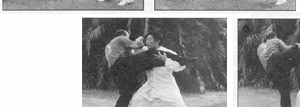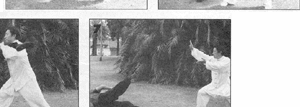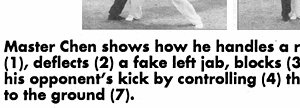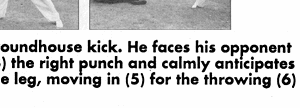Taijiquan > Chen Xiaowang - Keeper of the Taiji Secrets
Chen Xiaowang - Keeper of the Taiji Secrets
The following article first appeared in “Inside Kung Fu” Magazine October 1991:
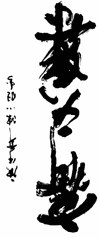 Chen Xiaowang, grandson of the famous Chen Fake, is recognized as the present-day keeper of Chen style taijiquan. In this rare interview, master Chen reveals the true history of his family’s style.
Chen Xiaowang, grandson of the famous Chen Fake, is recognized as the present-day keeper of Chen style taijiquan. In this rare interview, master Chen reveals the true history of his family’s style.
It is not very often one comes across a genuine kung-fu master. In my 20 years of searching the world over (especially in China) for a true teacher, I can honestly say I have not met more than six martial artists whom I can consider a “master” in the true sense of the word. So it was with great fortune that I have managed somehow to have master Chen Xiaowang stay with me for a while in my home, and to study with him daily. Master Chen is the son of Chen Zhaoxu, the eldest son of the Chen family taiji master, Chen Fake. As such, he is recognised as the present-day (19th generation) keeper of the Chen style taijiquan. Master Chen was born in 1945 in Chenjiagou Village, Henan province. He began the study of his family art of taiji at the age of 7 by his father and his uncles Zhaokui and especially Zhaopi. Master Chen was awarded the taijiquan gold medal at three consecutive National Wushu Tournaments from 1980 – 1982 and was again crowned the taijiquan Champion at the First International Wushu Competition held in Xian in 1985. Before he left China, master Chen was chairperson of the Henan province Chen Push Hand Taijiquan Association, deputy head of the Wushu Academy of Henan province, and technical advisor and official assessor for the standardised competition routines for the Chen, Yang, Wu and Soon styles of taijiquan. Since 1988, he has been a senior wushu instructor (equivalent to a university associate professor) in China. Apart from his martial prowess Master Chen is also a keen calligrapher and a noted author. He has written three books on taijiquan and is the committee member of the Society of Chinese Calligraphy and Literature. Since 1985, Chen has travelled to teach in Japan, Singapore, Malaysia and the U.S. At present he is visiting Australia and is conducting seminars in major cities. Our interview was conducted in Mandarin. I have translated and edited master Chen’s conversation with the help of his written notes in Chinese and his books.
HC: Master Chen can you start by telling us the origin of Chen style taijiquan?
CXW: We can start with my ancestor, Chen Bu, the first generation. He was originally from Shanxi province. Nearing the end of the Ming Dynasty, over 500 years ago Chen Bu migrated to Henan province and moved his family to present day Chenjiagou Village in the County of Wenxian. At that time the village was called Changyang village (mainly consisting of people with the surnames Chang and Yang). When the Chen clan prospered and its population increased, the village name was changed to Chenjiagou (‘Chen’ - surname, ‘Jia’ - the family of, ‘Gou’ - gully or ravine, because the village lies in a gully not far from the Yellow River). Chen Bu was an accomplished martial artist, so everyone in my village has been practising kung-fu since then. Nothing very much happened until the ninth generation, the time of Chen Wanting, who was an outstanding scholar and martial artist.
HC: I have heard Chen Wanting was a fearsome fighter. Was there anything written about him in the family record?
CXW: Yes, in our “Genealogy of the Chen Family”, it was recorded: “Wanting, alias Zhouting, was a knight at the end of the Ming dynasty and a scholar in the early years of the Qing dynasty. He was known in Shangdong province as a master of martial arts, once defeating more than 1,000 bandits. He was the originator of the bare-handed and armed-combat boxing of the Chen school. He was a born warrior, as can be proved by the broadswords he used in combat…”
HC: Is the sword still there?
CXW: (Smiling) No. It was a long time ago…besides, the Cultural Revolution has destroyed most of the relics. We are lucky to have kept some of the written records of the family.
HC: So Chen Wanting invented taijiquan?
CXW: Yes. Between 1930 and 1932 Tang Hoa, a well known and respected martial arts historian, was commissioned by the then government to find out the truth. He came to our village three times, went through our family records and did a lot of research. He was sure that taijiquan was originated from Chen Wanting of Chenjigou in the middle of the 17th century.
HC: Do you agree with him?
CXW: Yes I do. After the downfall of the Ming dynasty, the political scene was volatile and the society was in turmoil. Chen Wanting withdrew from public life and retired to live in the village. He wrote not long before his death: “Recalling past years, how bravely I fought to wipe out enemy troops and what risk I went through. All the favours bestowed on me are now in vain! Now old and feeble, I am accompanied only by the book of Huang Ting (a classic on qigong). Life consists in creating actions of boxing when feeling depressed, doing field work when the season comes and spending leisure time teaching disciples and children so they can be worthy members of society”. Because Chen Wanting had fought in many battles and travelled and read widely, he was able to combine many good points from other schools and from his past experience, and build upon what was passed down by Chen Bu to create a unique system of martial arts.
HC: What was so special about Chen Wanting’s taijiquan?
CXW: One, he synthesized many forms of boxing into one system. He was especially influenced by the writing of General Qi Jiguang (The 32 forms of the Canons of Boxing) – a collection of forms from 16 schools. Two, he utilized the theory of yin and yang as the theoretical basis of his martial arts. Three, he combined traditional Chinese medical theories (e.g. jingluo and acupuncture) and techniques of daoyin (the concentrated exertion of inner force) and tuna (deep breathing exercises) into his system. Four, he invented the chanxi (‘reeling silk’) techniques and the push hands exercises.
HC: What was the content of Chen Wanting’s taijiquan?
CXW: It had five sets of taijiquan, one set of paocui, one set of changquan; consisting of 108 movements, all types of weapons, five methods of push hands and two-person “sticky spear” and other types of practice routines with weapons.
HC: Is there anyone still practising these routines?
CXW: No, not the fist forms anyway. During the 14th generation, Chen Changxing (1771 –1853) condensed all the fist forms into two sets. We now call them ‘laoji’ (the ‘old family’ sets) to distinguish them from the ‘xinjia’ (the ‘new family’ set) created by my grandfather Chen Fake (1887 – 1957). The first set of laoji is quite slow, it can be used to train the student to awaken and to get a feel of the qi. The second set, also called paocui, is fast and powerful, where the student is taught to ‘fa jing’ (explosive power). The two sets of xinjia are similar to the laoji except they require more subtle use of energy and dynamic force and are generally more difficult to perform well than the laojia. The push hands and the weapons routine remain much the same to this day.
HC: I understand you have now further condensed the laoji and xinjia forms into one ‘thirty eight’ form. Can you tell us something about this new creation?
CXW: In the ‘thirty eight’ form, I have tried to do away with all the repetitions and to simplify the too-difficult moves, without destroying the characteristics of Chen style taijiquan, especially the attack-defence content and the chanxi techniques. The whole set is divided into four sections each with nine movements. It takes three to four minutes to perform. You can practice it either in a slow gentle way or in a fast and vigorous fashion with jumps and ‘fa jing’, it all depends on your age or inclination. It’s quick and easier to learn and I think it is a good way to popularise the Chen style taijiquan.


HC: We all know the Yang, the Wu and the Soon styles evolved from the Chen, Can you tell us the main difference between Chen and the other styles?
CXW: Well, they all have unique characteristics. Generally speaking, the names of the movements are different and sometimes the intentions are different. Chenjiagou tai chi has more weapon forms – apart from the sword and the sabre there is the spear, the staff, the kwan do and the two-person weapons forms. In Chen style taijiquan all the sets have ‘fa jing’ movements that other styles tend to neglect or not show at all. Chen style taijiquan is for fighting as well as for health.
HC: What about chanxi jing (‘reeling silk energy’)?
CXW: Chanxi jing is a unique characteristic of Chen style taiji. The other styles don’t have much of these spiral-like spinning and twisting movements.
HC: And push hands?
CXW: Chen style push hands tended to be done in a moving fashion. One attacks forward while the other retreats backward, front on or side on and so forth. The other styles like to do it in a more or less stationary manner, with less ‘fa jing’ and less aggressive moves. We also tend to use chin na and take-downs a lot. We treat push hands as a mockfight rather than an exercise. You have to be thrown around a lot to know what your ‘qi’ or your ‘jing’ is doing.
HC: Speaking as one who has only done Yang style, can one achieve mastery of taiji by doing any one of these styles?
CXW: Of course. They all come from the one source. The principles are the same. What style you do is immaterial. With a good teacher, hard work and perseverance, everything is possible.
HC: Master Chen, you are making it sound so easy. I have also heard that you are a keen calligrapher and that you apply the same taiji principles to your calligraphy. Is that so?
CXW: Yes. Both taiji and calligraphy involve the same ‘transportation of qi’ (yun qi) in our body. When I fight, I try to transport my qi to the point of impact without friction, still maintaining maximum efficiency. When I write, I try to do the same, except it is the tip of my brush. I practice my calligraphy the same way I do my taiji – with correct postures, relaxation and efficient ‘yun qi’. Both activities complement each other.


